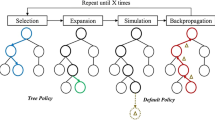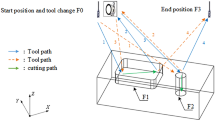Abstract
The machining sequence of machining features is vital to achieve efficient and high quality manufacturing of complex NC machining parts. In most feature-based process planning system, the machining features are sequenced as the lowest level unit. However, a single machining feature of complex parts such as aircraft structural parts is usually machined by multiple machining operations. The one-to-many mappings between the machining features and the machining operations cause the increase of the non-cutting tool path. In order to solve this problem, some types of machining features of complex parts are decomposed into several sub-machining features that are associated with a single machining operation individually according to the rules which are abstracted from the machining process of complex parts. Benefitting from the decomposition, the sub-machining features from different machining feature can be assembled into a sub-machining feature in order to avoid the cutting tool marks. The different types of sub-machining features are sequenced in the light of some rules which are also extracted from the machining process of complex parts. And the branch-and-bound algorithm are employed to sequence the same type sub-machining features to minimum the non-cutting tool path. A pilot feature-based process planning system has been developed based on this research, and has been used in some aircraft manufacturers in China.





Similar content being viewed by others
References
Britton, G., Thimm, G., Beng, T. S., & Jiang, F. (2002). A graph representation scheme for process planning of machined parts. The International Journal of Advanced Manufacturing Technology, 20(6), 429–438.
Deja, M., & Siemiatkowski, M. S. (2012). Feature-based generation of machining process plans for optimised parts manufacture. Journal of Intelligent Manufacturing. doi:10.1007/s10845-012-0633-x.
Gao, S., & Shah, J. J. (1998). Automatic recognition of interacting machining features based on minimal condition subgraph. Computer-Aided Design, 30(9), 727–739.
Gopala Krishna, A., & Mallikarjuna Rao, K. (2006). Optimisation of operations sequence in CAPP using an ant colony algorithm. The International Journal of Advanced Manufacturing Technology, 29(1–2), 159–164.
Guo, Y. W., Mileham, A. R., Owen, G. W., Maropoulos, P. G., & Li, W. D. (2009). Operation sequencing optimization for five-axis prismatic parts using a particle swarm optimization approach. Proceedings of the Institution of Mechanical Engineers, Part B: Journal of Engineering Manufacture, 223(5), 485–497.
ISO (2006). Automation systems and integration — Product data representation and exchange. In: AP 224, Mechanical product definition for process plans using machining features: ISO.
Li, Y. G., Ding, Y. F., Mou, W. P., & Guo, H. (2010). Feature recognition technology for aircraft structural parts based on a holistic attribute adjacency graph. Proceedings of the Institution of Mechanical Engineers, Part B: Journal of Engineering Manufacture, 224(2), 271–278.
Liu, X.-J., Yi, H., & Ni, Z.-H. (2010). Application of ant colony optimization algorithm in process planning optimization. Journal of Intelligent Manufacturing, 24(1), 1–13.
Liu, Z., & Wang, L. (2007). Sequencing of interacting prismatic machining features for process planning. Computers in Industry, 58(4), 295–303.
Reddy, S. V. B. (1999). Operation sequencing in CAPP using genetic algorithms. International Journal of Production Research, 37(5), 1063–1074.
Salehi, M., & Bahreininejad, A. (2011). Optimization process planning using hybrid genetic algorithm and intelligent search for job shop machining. Journal of Intelligent Manufacturing, 22(4), 643–652.
Tseng, Y.-J., & Joshi, S. B. (1998). Recognition of interacting rotational and prismatic machining features from 3-D mill-turn parts. International Journal of Production Research, 36(11), 3147–3165.
Waiyagan, K., & Bohez, E. L. J. (2009). Intelligent feature based process planning for five-axis mill-turn parts. Computers in Industry, 60(5), 296–316.
Wong, T. N., Chan, L. C. F., & Lau, H. C. W. (2003). Machining process sequencing with fuzzy expert system and genetic algorithms. Engineering with Computers, 19(2–3), 191–202.
Wu, C.-C., Hsu, P.-H., Chen, J.-C., Wang, N.-S., & Wu, W.-H. (2010). Branch-and-bound and simulated annealing algorithms for a total weighted completion time scheduling with ready times and learning effect. The International Journal of Advanced Manufacturing Technology, 55(1–4), 341–353.
Yan, X., Yamazaki, K., & Liu, J. (2000). Recognition of machining features and feature topologies from NC programs. Computer-Aided Design, 32(10), 605–616.
Acknowledgments
This work is funded by the National Science and Technology Major Project of China (2012ZX04010041).
Author information
Authors and Affiliations
Corresponding author
Rights and permissions
About this article
Cite this article
Wang, W., Li, Y. & Huang, L. Rule and branch-and-bound algorithm based sequencing of machining features for process planning of complex parts. J Intell Manuf 29, 1329–1336 (2018). https://doi.org/10.1007/s10845-015-1181-y
Received:
Accepted:
Published:
Issue Date:
DOI: https://doi.org/10.1007/s10845-015-1181-y




